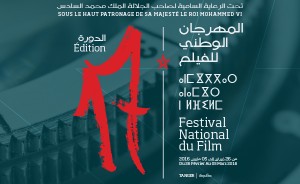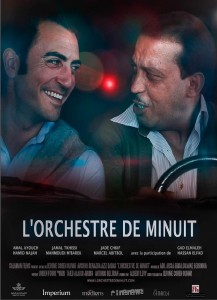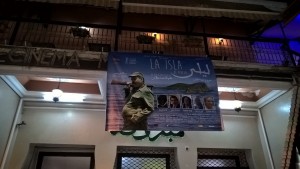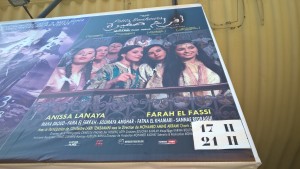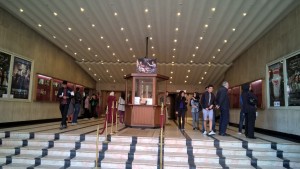There was a double presence for Moroccan cinema in Berlin this February for the 66th Berlinale at both the festival and European Film Market (the market for industry professionals linked to the festival).
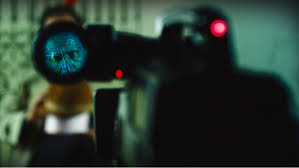 In the film festival itself, Casablancan director Hicham Lasri had his new feature film, Starve your dog selected for the Panorama section of the Berlinale (the section of the festival with a particular interest in promoting auteur cinema or discovering new talent). Lasri has achieved the notable feat of being selected for the Berlinale two years in a row – having made his mark on the festival last year with The Sea is Behind (2014). Starve your dog had already premiered at the Toronto International Film Festival in September 2015 and is the second part of Lasri’s self-styled ‘dog’ trilogy of films that began with C’est eux les chiens in 2013. The film continues Lasri’s preference for formal abstraction and cinematic experimentation (with both sound and image) as a means of exploring contemporary socio-political realities in Morocco, and was well received by critics at both Toronto and Berlin. Stephen Dalton described the film as both ‘an emphatically surreal oddity pitched at ultra-niche arthouse and festival crowds’ and ‘part of a growing body of films addressing the aftermath of the Arab Spring in an arty, non-naturalistic manner’.
In the film festival itself, Casablancan director Hicham Lasri had his new feature film, Starve your dog selected for the Panorama section of the Berlinale (the section of the festival with a particular interest in promoting auteur cinema or discovering new talent). Lasri has achieved the notable feat of being selected for the Berlinale two years in a row – having made his mark on the festival last year with The Sea is Behind (2014). Starve your dog had already premiered at the Toronto International Film Festival in September 2015 and is the second part of Lasri’s self-styled ‘dog’ trilogy of films that began with C’est eux les chiens in 2013. The film continues Lasri’s preference for formal abstraction and cinematic experimentation (with both sound and image) as a means of exploring contemporary socio-political realities in Morocco, and was well received by critics at both Toronto and Berlin. Stephen Dalton described the film as both ‘an emphatically surreal oddity pitched at ultra-niche arthouse and festival crowds’ and ‘part of a growing body of films addressing the aftermath of the Arab Spring in an arty, non-naturalistic manner’.
The film’s fragmented, episodic narrative is loosely based around an interview that is waiting to take place between a Moroccan journalist and Driss Basri, the former, feared Minister of the Interior under Hassan II during the so-called Years of Lead. In reality, Basri died in 2007 – having been exiled to France in 1999 when Mohammed VI ascended to the throne – though, for the purposes of his film, Lasri has Basri returning from house arrest (and ready to expose the secrets of his past from the regime of Hassan II to the expectant journalist). Unfortunately, I was unable to see Starve your Dog during my brief visit to this year’s Berlinale – infuriatingly, the film was screened the day before my arrival and then on the final Friday of the festival, by which time I had already returned to the UK. I hope to see this important film very soon. In the meantime, see these reviews from the Hollywood Reporter and the Middle East Institute, as well as this interview with the director by editor-in-chief of Africultures, Olivier Barlet, at the Festival des Cinémas d’Afrique du Pays d’Apt in 2015 for more on Starve your dog and its director.
The second cinematic présence marocaine in Berlin this February was to be found at the European Film Market. The EFM, one of the most important events in the international industry calendar for sales agents, distributors, producers and national film councils, runs concurrently with the film festival. Whilst the festival itself is very much open to the public (throughout the Berlinale, you can see long queues of cinephiles queuing for the chance to buy a ticket to see one of the 400 or so films that are screened in the various sections of the festival), the EFM is quite distinct: a space for industry professionals. Situated in two main locations near Potsdamer Platz, the market is made of a mixture of private companies and national/transnational film commissions and agencies who are there to make deals, buy and sell the rights to films and – in the case of the national film councils – promote their national cinema. This year, as announced six months before, the CCM took the decision to pay for an individual stand at the EFM – principally to promote the 20% rebate offered to foreign films that are partially or completely shot in Morocco. This kind of tax credit or tax incentive has emerged as a common strategy amongst certain national cinemas (e.g. Canada and Spain) and even in individual regions or states (most notably in the US) as a means to incentivise foreign productions to a shoot in the country. The pay-off comes in relation to the investment and associated spend made by the production companies on both film industry technicians and resources (studio space, equipment hire) as well as the money that should (in theory) flow into the local economy during the shoot. For the Director of the CCM, Sarim Fassi Fihri, in post since late 2014, the 20% rebate (passed by the Moroccan government in December 2015), alongside new tax schemes aimed at supporting the domestic exhibition centre, forms a key part of his plans for developing the Moroccan film industry [see Sarim Fassi Fihri’s interview with Martin Dale in Variety, December 2015].
Morocco has a long and highly successful tradition of attracting foreign film production to shoot in the kingdom – from Orson Welles’ cinematic adaptation of Shakespeare’s Othello (1952) to modern epics such as Gladiator (Ridley Scott, 2000) and blockbuster comedies such as Asterix & Obélix: mission Cleopatre (Chabat, 2002). The presence of representatives from CLA Studios and Atlas Corporation Studios at the Moroccan stand, working alongside the CCM in Berlin, was evidence of how important this policy clearly is to promoting investment in the Moroccan film industry of the 21st century. What remains to be seen is if such investment in the more commercial end of the Moroccan film industry can also have a positive effect on the sustained development of all areas of the national cinema culture and Moroccan film art – including the films of Moroccan directors such as Hicham Lasri, working on more experimental, auteur-led independent productions.
Will Higbee
